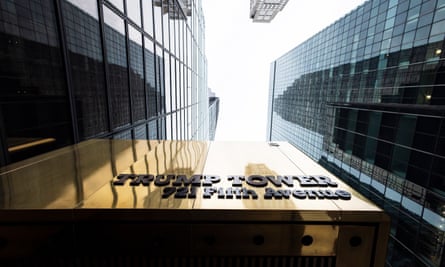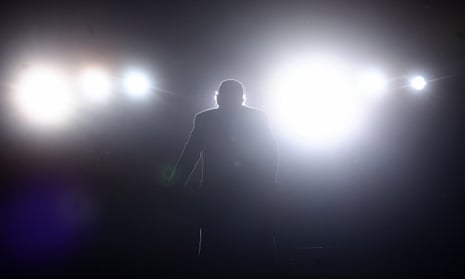When Donald Trump announced plans in 2006 to build a golf complex on ancient sand dunes on the Aberdeenshire coast in Scotland he told reporters it was love at first sight. “As soon as I saw it there was no question about it,” he said. It would be the world’s “greatest golf course”.
This week Trump International Scotland became a central element of a case that looks poised to dominate his post-presidential life, and could even put him behind bars.
Local fishermen denounced Trump as a “loudmouth bully” during construction of the course. Environmentalists warned the development would destroy the natural habitat, and sure enough it did inflict such damage that the site was stripped of its protected status.
But none of this deflected Trump from his goal. Today, the Scottish complex stands as a “premier luxury golf” experience replete with five-star hotel and helicopter landing pad, at a bargain membership of £2,595 ($3,518) a year.
Fifteen years on, the property has done wonders for its owner. That is, if you measure success according to the idiosyncratic accounting style of Donald Trump.
He bought the 2,000 acres (809 hectares) site at Menie in 2006 for $12.6m. Within five short years it was valued by the Trump Organization in its financial statements at $161m, an increase of almost 13 times.
By 2014, the windswept Scottish holding was put at $436m.
The hike caught the attention of Letitia James, New York state’s progressive attorney general known for her relentless pursuit of the rich and powerful. How the Scottish property came to rise meteorically in value is one of the matters she is exploring in her continuing investigation into Trump Organization finances.

In a new filing released this week designed to pressure Trump and two of his children – Ivanka and Donald Jr – into facing questioning, James forensically dissects how such strikingly large valuations came about. The 2011 estimate for the Scottish property, her investigators discovered, included an estimated £75m ($121m at 2011 exchange rates) for undeveloped land at the site.
Investigating deeper, they found that the figure had been created for an article in Forbes magazine. The revelation prompted a line in this week’s filing that must be among the tartest in US financial history.
“It thus appears,” James writes, “that the valuation of Trump Aberdeen used for Mr Trump’s financial statement was prepared for purposes of providing information to Forbes magazine in a quote.”
James’s legal document is packed with similarly juicy titbits. The 2014 value of the Scottish golf club was based in part on the projected sale price of 2,500 houses on the land, even though none of the houses actually existed and the company had planning permission for only half that number.
In 1995 the Trump Organization bought a parcel of land in Westchester, New York, known as the Seven Springs Estate, for $7.5m. By 2004 it was valued at $80m and by 2014 at $291m. That 2014 figure, James notes in another exquisitely tart reference, included a valuation of $161m for “seven non-existent mansions”.
The juiciest titbit of all concerns Trump’s former home, the gilded Fifth Avenue temple to his own ego dubbed “Versailles in the sky”, in which he lived before moving into the White House. James’s investigators were puzzled to find the Trump Tower triplex in Manhattan was listed at $327m in 2015, based on the apartment’s size, allegedly 30,000 sq feet.
In fact the property is 11,000 sq feet, which produces a value of $117m. That’s an overstatement in Trump’s official financial statements of more than $200m.

Such startling disparities matter, James insists in her 114-page filing. The financial statements that contained them were used to secure loans from banks as well as insurance, and in other instances to reduce Trump’s tax burden.
“We have uncovered significant evidence that suggests Donald J Trump and the Trump Organization falsely and fraudulently valued multiple assets and misrepresented those values to financial institutions for economic benefit,” James said after the filing was lodged in a New York court.
The new material disclosed by James was so compelling that some close observers of Trumpland are now convinced that he is in serious legal trouble. Michael Cohen, Trump’s former personal attorney and an ex-vice president of the Trump Organization, told the Guardian: “The House of Trump is crumbling.”
Cohen, who was released in November from house arrest having had his own legal difficulties, has skin in this game. It was his testimony to the House oversight committee in February 2019 that sounded the alarm over allegedly inflated evaluations in Trump’s financial statements, which in turn prompted James to open her investigation the following month.
“My testimony before the committee as well as my subsequent cooperation with the New York attorney general has led to this day,” Cohen said. “We are seeing individuals who have continuously escaped responsibility for their actions finally being held accountable.”
James is pursuing her investigation as a civil case, which means that were Trump to be found liable it could cost him heavily in fines and penalties. More seriously, James is working in coordination with the Manhattan district attorney, Alvin Bragg, a similarly tenacious and relentless prosecutor equipped with a large and highly experienced team of investigators.
Bragg is asking exactly the same questions as James: did the Trump Organization commit accounting, bank, tax or insurance fraud? The critical difference is that Bragg’s investigation is criminal, threatening Trump not with fines but prison time.
“Trump could end up in an orange jumpsuit at the end of that one,” said Timothy O’Brien, a senior columnist for Bloomberg Opinion.
O’Brien also has a personal stake in this story. His book TrumpNation, a 2005 biography that raised doubts about Trump’s actual wealth in eerily similar terms to the James and Bragg investigations today, so irked the real estate developer that he sued O’Brien for billions of dollars.
O’Brien’s lawyers deposed Trump as part of his defense. Over two days they managed to do something that has rarely been done before or since – they got the celebrity to acknowledge, no fewer than 30 times, that he had lied.
“My lawyers were so well prepared that when he sat down for the deposition we had documentary evidence at hand that showed the reality of what he had lied about or exaggerated. We simply pushed those over the table at him,” O’Brien recalled.
Many of the misleading elements – the value of his golf clubs, real estate assets in New York – were virtually identical to the details contained in this week’s filing. Which is why O’Brien feels confident in saying that the patterns that James outlines in her court document extend far back.
“This is behaviour that Trump has been engaging with since he was a toddler, frankly,” O’Brien said.
The libel suit was dismissed in 2009. The author was surprised that despite the mass of detail he had exposed in TrumpNation of potential malfeasance, no prosecutor showed interest.
“There was ample fodder in my book for prosecutors to pursue, but nobody picked it up. Law enforcement simply didn’t take Donald Trump seriously until it was too late.”
Times have changed. Trump is no longer a real estate magnate-turned-reality TV star, he is a former US president. The stakes have increased significantly and with them the scrutiny.
Never before has Trump been confronted by two coordinated teams of sophisticated investigators raking through his financial affairs, with both civil and criminal charges possibly pending.
Just how serious the prosecutors are about nailing their man is revealed in a single sentence of James’s new filing. She writes that the investigative team is determined to find out “Mr Trump’s actual knowledge of – and intention to make – the numerous misstatements and omissions made by him or on his behalf.”
“Intention to make” indicates that James is not only thinking along civil lines. She is also anticipating possible criminal charges in which proof of the intent of the accused is required.
Trump continues to resist giving testimony, as do his two children, on grounds that the investigations are politically motivated witch hunts (both James and Bragg are Democrats). A third child, Eric, who runs the day-to-day work of the Trump Organization, was deposed but pleaded the fifth more than 500 times.
The family’s best hope is that the prosecutors will struggle to meet the high bar that is set for criminal cases. That is especially so when it comes to the critical issue of intent, said Robert Mintz, a former federal prosecutor.
“The criminal case is more dangerous since it involves potential incarceration. But it requires criminal intent and that is difficult to prove, particularly in complex financial frauds involving organizations,” Mintz, now a partner at McCarter & English, LLP told the Guardian.
Prosecutors will have to prove that Trump knowingly and willfully violated the law. That can be tough – showing discrepancies in financial statements, juicy though they may be, is not enough.
“Large investigations take time and are exceedingly difficult to prove without the help of cooperating witnesses and documentation,” Mintz said. “These parallel investigations are clearly moving ahead, but how they will end is difficult to predict.”
